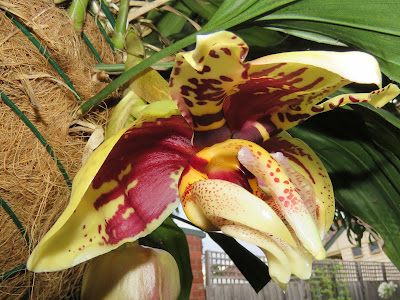Popping out to see the upside down orchid
This is what we awoke to yesterday, the 23rd of January. A 15 cm wide, fleshy, orchid flower emerging from a basket brimming with pseudobulbs (the swollen bits at the base of the aspidistra-like leaves). It's a Stanhopea, induced into flower by either Lynda fertilising it last week or a liking for the recent warm and (particularly if we keep the water up) humid weather.
Species of this genus are sometimes called Upside Down Orchids, referring to the propensity for the flowering stem to head downwards, or slightly misleadingly Bucket Orchids, a name more often applied to the related genus Coryanthes which does have a 'bucket' as part of its floral apparatus.
We first noticed buds on Saturday afternoon (21 January), exactly one year after friends Maggie and Max Richards gave us half of their Stanhopea basket plant. We were to look after it, and try and get it to flower. Job done!
That said, it hasn't looked great for most of the time, with leaves a bit tattered and browned. We moved house in April, meaning its microhabitat changed from subtropical Hawthorn to subtropical Glen Iris, so that may not have helped. Typically it prefers the subtropics of more northern parts of Australia I suspect. Still, in its final resting place under this nectarine tree it seems happy enough. At least happy enough to flower.
The flower buds had presumably been there a day or two, or even more. After Lynda spotted the first two we noticed a younger second pair at the back of the basket. The two at the front though (below, photographed 21 January) looked like juicy, slightly deformed, capsicums, and ready to open any day...
It all happens quickly with Stanhopea so we kept vigil over the next few days. I had heard that their flowers audibly 'pop' open and it seems that mostly the popping occurs early in the morning: 5.30 am according to most reports or, if you are lucky, as late at 8.30 am.
I didn't hear a pop but at 6.00 am on 23 January this is what our flowers looked like - one open, one still shy. The open flowers are like porcelain, or plastic, depending on how much romance you want to evoke. The chunky insides must be like a theme-park ride for any willing pollinator.
In nature the flowers are pollinated in nature by a male (euglossine, or orchid) bee which visits the flower to collect aromatic substances from the waxy lips of the flower. On the way in, or out, it collects some of the orchid pollen to then carry to another flower.
And aromatic the flowers are. On the morning this flower opened there was a strong waft of a vanilla-like fragrance curling around my nose as I photographed what a male bee sees (in different colours) and experiences. In this bee-view picture, the pollen sits in a small notch behind that small pointy bit that seems to make the entrance to the ride unsafe.
It's fitting to seek information on this species from Royal Botanic Gardens Kew. Stanhopea was named by Sir William Hooker, an early Director of Kew, for a genus of orchids found mostly in tropical Central and South America.
There are now over 60 species known and I think ours is Stanhopea tigrina* (Tiger-spotted Stanhopea), from Mexico, perhaps the mostly commonly grown species of Stanhopea in Australia.
Stanhopea nigroviolacea is another name you'll see around for a plant with similar looking flowers. That species was in fact named originally as a variety of Stanhopea tigrina, and in the most recent version of Plant List you'll find Stanhopea tigrina var. nigroviolacea. 'Nigroviolacea' seems to have more of the maroon colour on the floral parts than mine but I'm happy to be corrected on this (now infraspecific) identification!
Stanhopea tigrina was named and described in 1837 by James Bateman, the author of a rather large (10 volume) publication on the orchids of Mexico and Guatemala. By the time this hand-coloured lithograph by W.H. Fitch appeared in Curtis’s Botanical Magazine, in 1845, the species was 'not uncommon' in the collections of UK plant enthusiasts.
You can find Stanhopea in cultivation around Australia, in the collections of orchid buffs mostly, but not too many in Melbourne; we grow it inside our Tropical Glasshouse in the Melbourne Gardens of Royal Botanic Gardens Victoria. Our home display is modest when you see some of the pictures on the web of the underside of baskets lined with flowers, but even one of these flowers is marvel enough.
When I got home last night the second flower in the pair was open. Apparently, Lynda says, it was open at 8.30 am, when she ventured into the Gardens. So maybe one at 5.30 or thereabouts, and the other closer to 8.30, just like the interweb said.
Thank you to the Richards family for a gift that took a year to deliver, but deliver it did.
*Sydney-based expert on exotic and local orchids (among other things), David Banks (via Facebook, 27 February 2017, when I reported another set of two flowers opening), says my plant is definitely Stanhopea nigroviolacea, and not Stanhopea tigrina. He posted a picture of a different looking flower, identified as Stanhopea tigrina, by Barney Greer "who wrote a book on this genus".







Comments
Are they in flower at the RBG this year?
Cheers Rob Dabal
Regards Ross
Diane O’Dwyer